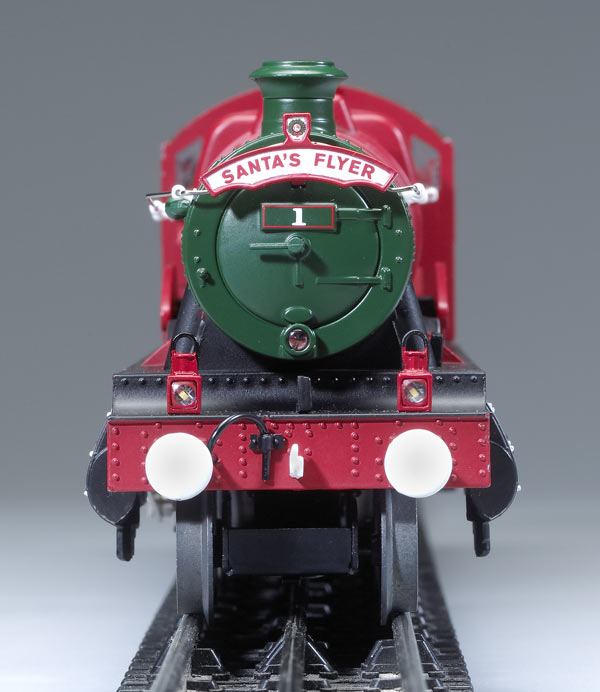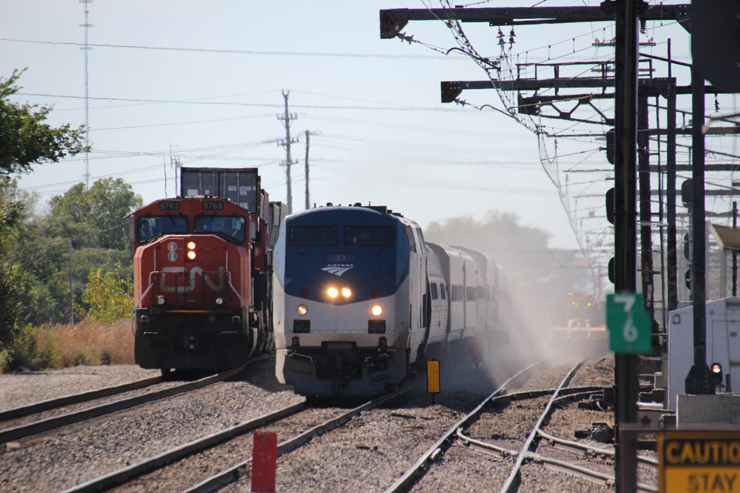I visited Sommerfeld’s Trains in Butler, Wis., looking for this O gauge locomotive. My goal was to get something I wouldn’t feel guilty about repainting into black London, Midland & Scottish colors. Now, before those who know this wasn’t an LMS prototype start asking how I could do such a thing, don’t worry. I saw the model and thought it looked so striking in the Christmas paint scheme that it probably wouldn’t get repainted. Well, maybe.
But it was a regular box full of Christmas eye candy. And based on its looks alone, I liked it well enough to squeeze it into the magazine even though the holidays were nearing an end (per the publishing schedule).
This model is the third outing for the UK-outline tooling created for the movie-related Hogwarts Express from the Harry Potter book and movie series. The second product was the Shakespeare Express (based on a British excursion train of the same name).
The Lionel product developers must have figured that the firm’s expanding line of Christmas trains was a good reason to dust off the tooling for another run. After all, the holidays are nothing if not whimsical, and this steamer packs plenty of whimsy.
The prototype for this model is a Great Western Ry. (the British line, not the Colorado sugar beet hauler) Hall-class 4-6-0 no. 5972 named Olton Hall. More than 300 were built and used in freight and passenger service. Built in 1937, Olton Hall was on the verge of being sold for scrap in 1964 before it was preserved. Since then, it has operated as something of a diva in heritage railway circles.
Opening the box
The things I liked about the Hogwarts still hold true for the Santa’s Flyer. It is a unique locomotive, with a pleasing mix of boxy (the pilot and the tender) combined with a fairly clean – even stark boiler. But what makes this version really pop is the painting. The careful application of red and black, plus the tasteful white lining, accentuates the good looks of the model.
The blunt pilot is just as businesslike as on the Hogwarts, though the white ends of the bumpers and the white hook of the coupler contrast wonderfully with the red face of the pilot and the black deck above.
The classification lanterns are red – but they possess black handles.
The face of the boiler is green, with a red-green-white number board in the center. Up top, the nameplate says “Santa’s Flyer” in red on white, and the crown has a wreath with Lionel’s familiar circle-L logo. I’m not sure why Lionel places the locomotive’s headlight at the bottom of the smokebox. I suppose you could easily paint it over if it really bothered you.
The boiler is clean and utilitarian, but not entirely devoid of detail. There are cast-in rivets and piping as well as bands on the boiler and firebox. The boiler bands are painted white.
The natural metal handrail has white stanchions; again, this contrasts nicely with the red boiler.
The steam chests are black with white accents, and the deck/sheath over the drivers is red on the sides and black on top, with white side stripes.
The cab roof is green, and the white numeral “1” is outlined on the flanks. The front and the first side windows have plastic window inserts. The cab interior is Spartan, just like a real British cab, but there is a nice level of cast-in detail on the firebox backhead.
There is a nice bit of riveting on the cab, and a grab iron that is also a support for the cab roof. Cool.
The running gear is basic at best, and the wheels lack any accent or special color trim.
The tender is terrific. Although the catalog describes it as having a metal frame, the model I bought is entirely plastic. It mounts small bumpers on the front and larger bumpers on the rear. All four are white.
The front of the tender has add-on grab irons and add-on cranks for the brakes. The cast-in coal load is painted black, which contrasts nicely with the tender’s red frame.
The rear of the tender has a “Santa’s Flyer” nameplate as well as add-on grab irons with white stanchions. You’ll find the white hook for British-style couplers just above the big knuckle coupler.
The painting of the tender was great. A green stripe is centered on the flank with white accents on top and bottom. In the center is “North Pole Central” in a typeface reminding me of one used by the New York Central. On the top of the tender is an additional white accent.
The tender’s side frame has a very satisfactory level of cast-in detail.
On the test track
I had only a few disappointments with this O gauge model.
Lionel’s catalog stated that the model has an electronic steam whistle. Someone suggested to me that the model was going to have a digital rendition of a British-style steam whistle. In fact, the tender contains a traditional Lionel air whistle.
There was also the big old knuckle coupler on the tender (for my two cents, it should have had an Ace-compatible link coupler).
The thumbtack-style knuckle coupler is plastic, and that’s probably the cheesiest part of the model. When pulling a load of three unpowered MTH subway cars, the coupler regularly opened. It also opened when it was pulling the Lionel jet snow blower (see next review), so it wasn’t just the weight.
A dab of glue (or a rubber band) might come in handy with this device.
The locomotive has two power pickup rollers spaced just less than 3 inches apart; the tender has two power pickup rollers about 3½ inches apart. There is no electrical connection between tender and locomotive rollers.
The smoke unit and the directional lock-out switches are located on the deck of the cab.
Smoke output was satisfactory, though keep in mind that the higher the power to the tracks, the more smoke you’ll see.
The classification lights were bright blue light-emitting diodes (LEDs), while the headlight was a bright yellow. I think the whistle really should have been British, but few people will know the difference and fewer still will care.
The Santa’s Flyer locomotive is satisfactory entry-level power. Operation was conventional only, and the low speed average was 20.1 scale miles per hour. The high-speed average was 67 scale miles per hour. The low-speed score was slightly better than the Hogwarts locomotive we tested in the February 2008 issue of Classic Toy Trains.
Pulling power was helped along by traction tires mounted on the rear drive wheels. The drawbar pull was 1 pound, 5 ounces, which was 8 ounces better than the previously tested Hogwarts locomotive.
All in all, Santa’s Flyer is responsive to transformer commands and is a passable light-duty machine. The 4-6-0 is a nice re-purposing of the Hall-class body by Lionel. The eccentric red, green, and white holiday colors muster a surprising amount of dignity, and this engine has more flair than a box full of holiday Dockside switchers.
It isn’t too early to get started on planning your Christmas 2010 operations, so get down to your hobby retailer before he or she puts the last of the Christmas gear away!
Price: $199.99 (no. 38671)
Features: O-36 operation, die-cast metal boiler, can-style motor, smoke unit, air whistle















I have one and am enjoying watch it pull the eight NPC passenger cars. The locomotive looks equally well pulling an assorment of recent vintage Lionel NPC rolling stock. The colors are a perfect match. The locomotive itself is diecast and has some heft, but there are delicate parts on it and the tender that might easily be broken by little hands. This may not be the best locomotive for a young railroader. The classification lanterns on the front have bright LED's in them. I believe this is a first for this style locomotive. Overall, I like it and believe it looks better than some of the other NPC locos out there.
I just purchased a Lionel Santa's Flyer this weekend and think it is great! I am using it to pull my 8-car North Pole Central passenger set and have had none of the problems with the tender coupler that Bob mentions having on his test model. I like the front-end LED lighting and the stately synchronized puffing from the smoke unit.